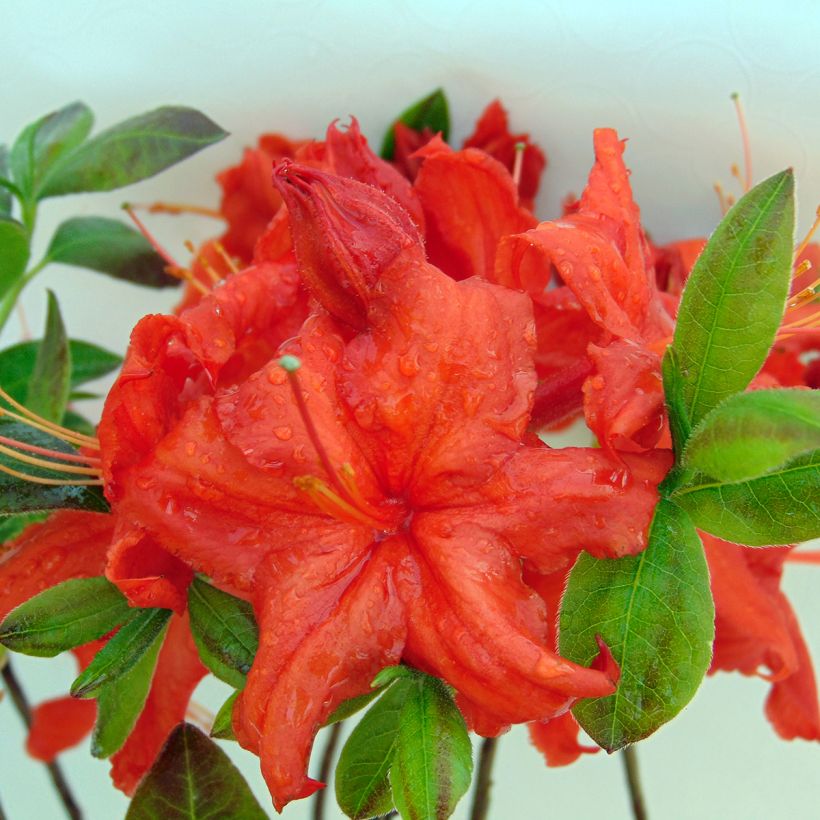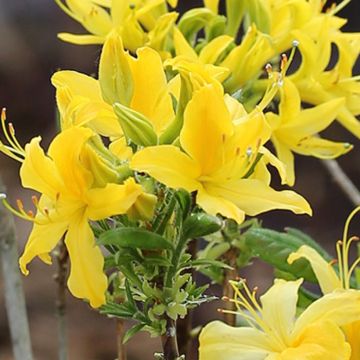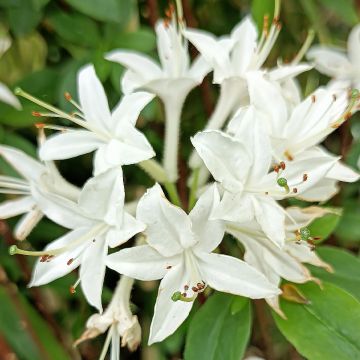

Azalea Fire Ball
Azalea Fire Ball
Rhododendron (Azalea) x knaphill Fire Ball
Knaphill Azalea, Hybrid Rhododendron
Thank you, these are not babies.
yvon, 16/02/2020
Special offer!
Receive a €20 voucher for any order over €90 (excluding delivery costs, credit notes, and plastic-free options)!
1- Add your favorite plants to your cart.
2- Once you have reached €90, confirm your order (you can even choose the delivery date!).
3- As soon as your order is shipped, you will receive an email containing your voucher code, valid for 3 months (90 days).
Your voucher is unique and can only be used once, for any order with a minimum value of €20, excluding delivery costs.
Can be combined with other current offers, non-divisible and non-refundable.
Home or relay delivery (depending on size and destination)
Schedule delivery date,
and select date in basket
This plant carries a 24 months recovery warranty
More information
We guarantee the quality of our plants for a full growing cycle, and will replace at our expense any plant that fails to recover under normal climatic and planting conditions.

Would this plant suit my garden?
Set up your Plantfit profile →
Description
The 'Fire ball' Azalea, also known as the Hybrid Rhododendron, is a deciduous bush, notable for its coppery foliage from spring to autumn and its reddish-orange flowers. It will enhance other plants in the background of an ericaceous bed.
Originally from China, the 'Fire ball' Azalea has an upright habit and reaches a height of 1.50m (4 ft 11 in) with a spread of 1m when fully grown. Its coppery foliage consists of ovate and flexible leaves. During the months of April and May, the bush will offer you abundant flowering, filling your garden with clusters of bright reddish-orange flowers with well-developed pistils and stamens. Its brown stems will stand out from the leaves and flowers, adding structure to this exuberance, an event not to be missed!
Hardy down to -20°C (1°F) (and vigorous, the 'Fire ball' Chinese Azalea requires full sun or partial shade exposure. This slow-growing bush thrives in acidic, humus-bearing soil and prefers cool, humus-rich, and well-drained soil.
Plant the 'Fire ball' Azalea on a slope, in a rock garden, or in the middle of a bed alongside Pieris, Heather, Kalmias, Andromedas, and Japanese Maple.
Divided into 2 horticultural groups, the Rhododendron genus includes: Azaleas, Chinese and Japanese, with small evergreen or deciduous leaves and 5 stamens per flower: Rhododendrons, with large, evergreen, and glossy leaves, and flowers with more than 10 stamens. Although highly debatable from a botanical point of view, this classification is still widely used by horticulture professionals.
Azalea Fire Ball in pictures




Plant habit
Flowering
Foliage
Botanical data
Rhododendron (Azalea)
x knaphill
Fire Ball
Ericaceae
Knaphill Azalea, Hybrid Rhododendron
Cultivar or hybrid
Other Chinese Azalea
View all →Planting and care
Plant Azalea 'Fire ball' in full sun or partial shade, protected from cold and drying winds, in moist, humus-bearing and light soil with an acidic tendency. Like all plants that prefer acidic soil, it cannot tolerate limestone soils or heavy soils waterlogged in winter. Dig a hole three times larger than the pot. Soak the root ball in non-limestone water and plant the bush at the level of the collar, in a mixture composed of soil, leaf compost, gravel or pumice, and loam. Water generously and keep the soil moist in summer. Azaleas and Rhododendrons have a shallow root system, which makes them susceptible to long periods of drought. That's why it's recommended to enrich the soil with humus and provide abundant watering during drought periods. Additionally, this root system is not very strong, so it is essential to lighten heavy soils with draining materials (gravel, pumice, clay pellets) at planting. Apply a mulch of crushed pine bark around the base of the bush every spring to maintain soil moisture while preserving an acidic pH. Maintenance involves cutting off faded flowers in summer and removing dead branches. Azaleas and Rhododendrons can sometimes be attacked by weevils, which eat the edges of leaves and rootlets, as well as the infamous "rhododendron borer," which is rare, but can cause significant damage. Yellowing of leaves (chlorosis) in Rhododendrons indicates poor iron assimilation in the soil and can lead to premature death of the plant. While limestone is often the cause, poorly drained soil or deep planting can also explain the condition.
Planting period
Intended location
Care
Planting & care advice
-
, onOrder confirmed
Reply from on Promesse de fleurs
Similar products
Haven't found what you were looking for?
Hardiness is the lowest winter temperature a plant can endure without suffering serious damage or even dying. However, hardiness is affected by location (a sheltered area, such as a patio), protection (winter cover) and soil type (hardiness is improved by well-drained soil).

Photo Sharing Terms & Conditions
In order to encourage gardeners to interact and share their experiences, Promesse de fleurs offers various media enabling content to be uploaded onto its Site - in particular via the ‘Photo sharing’ module.
The User agrees to refrain from:
- Posting any content that is illegal, prejudicial, insulting, racist, inciteful to hatred, revisionist, contrary to public decency, that infringes on privacy or on the privacy rights of third parties, in particular the publicity rights of persons and goods, intellectual property rights, or the right to privacy.
- Submitting content on behalf of a third party;
- Impersonate the identity of a third party and/or publish any personal information about a third party;
In general, the User undertakes to refrain from any unethical behaviour.
All Content (in particular text, comments, files, images, photos, videos, creative works, etc.), which may be subject to property or intellectual property rights, image or other private rights, shall remain the property of the User, subject to the limited rights granted by the terms of the licence granted by Promesse de fleurs as stated below. Users are at liberty to publish or not to publish such Content on the Site, notably via the ‘Photo Sharing’ facility, and accept that this Content shall be made public and freely accessible, notably on the Internet.
Users further acknowledge, undertake to have ,and guarantee that they hold all necessary rights and permissions to publish such material on the Site, in particular with regard to the legislation in force pertaining to any privacy, property, intellectual property, image, or contractual rights, or rights of any other nature. By publishing such Content on the Site, Users acknowledge accepting full liability as publishers of the Content within the meaning of the law, and grant Promesse de fleurs, free of charge, an inclusive, worldwide licence for the said Content for the entire duration of its publication, including all reproduction, representation, up/downloading, displaying, performing, transmission, and storage rights.
Users also grant permission for their name to be linked to the Content and accept that this link may not always be made available.
By engaging in posting material, Users consent to their Content becoming automatically accessible on the Internet, in particular on other sites and/or blogs and/or web pages of the Promesse de fleurs site, including in particular social pages and the Promesse de fleurs catalogue.
Users may secure the removal of entrusted content free of charge by issuing a simple request via our contact form.
The flowering period indicated on our website applies to countries and regions located in USDA zone 8 (France, the United Kingdom, Ireland, the Netherlands, etc.)
It will vary according to where you live:
- In zones 9 to 10 (Italy, Spain, Greece, etc.), flowering will occur about 2 to 4 weeks earlier.
- In zones 6 to 7 (Germany, Poland, Slovenia, and lower mountainous regions), flowering will be delayed by 2 to 3 weeks.
- In zone 5 (Central Europe, Scandinavia), blooming will be delayed by 3 to 5 weeks.
In temperate climates, pruning of spring-flowering shrubs (forsythia, spireas, etc.) should be done just after flowering.
Pruning of summer-flowering shrubs (Indian Lilac, Perovskia, etc.) can be done in winter or spring.
In cold regions as well as with frost-sensitive plants, avoid pruning too early when severe frosts may still occur.
The planting period indicated on our website applies to countries and regions located in USDA zone 8 (France, United Kingdom, Ireland, Netherlands).
It will vary according to where you live:
- In Mediterranean zones (Marseille, Madrid, Milan, etc.), autumn and winter are the best planting periods.
- In continental zones (Strasbourg, Munich, Vienna, etc.), delay planting by 2 to 3 weeks in spring and bring it forward by 2 to 4 weeks in autumn.
- In mountainous regions (the Alps, Pyrenees, Carpathians, etc.), it is best to plant in late spring (May-June) or late summer (August-September).
The harvesting period indicated on our website applies to countries and regions in USDA zone 8 (France, England, Ireland, the Netherlands).
In colder areas (Scandinavia, Poland, Austria...) fruit and vegetable harvests are likely to be delayed by 3-4 weeks.
In warmer areas (Italy, Spain, Greece, etc.), harvesting will probably take place earlier, depending on weather conditions.
The sowing periods indicated on our website apply to countries and regions within USDA Zone 8 (France, UK, Ireland, Netherlands).
In colder areas (Scandinavia, Poland, Austria...), delay any outdoor sowing by 3-4 weeks, or sow under glass.
In warmer climes (Italy, Spain, Greece, etc.), bring outdoor sowing forward by a few weeks.



























































